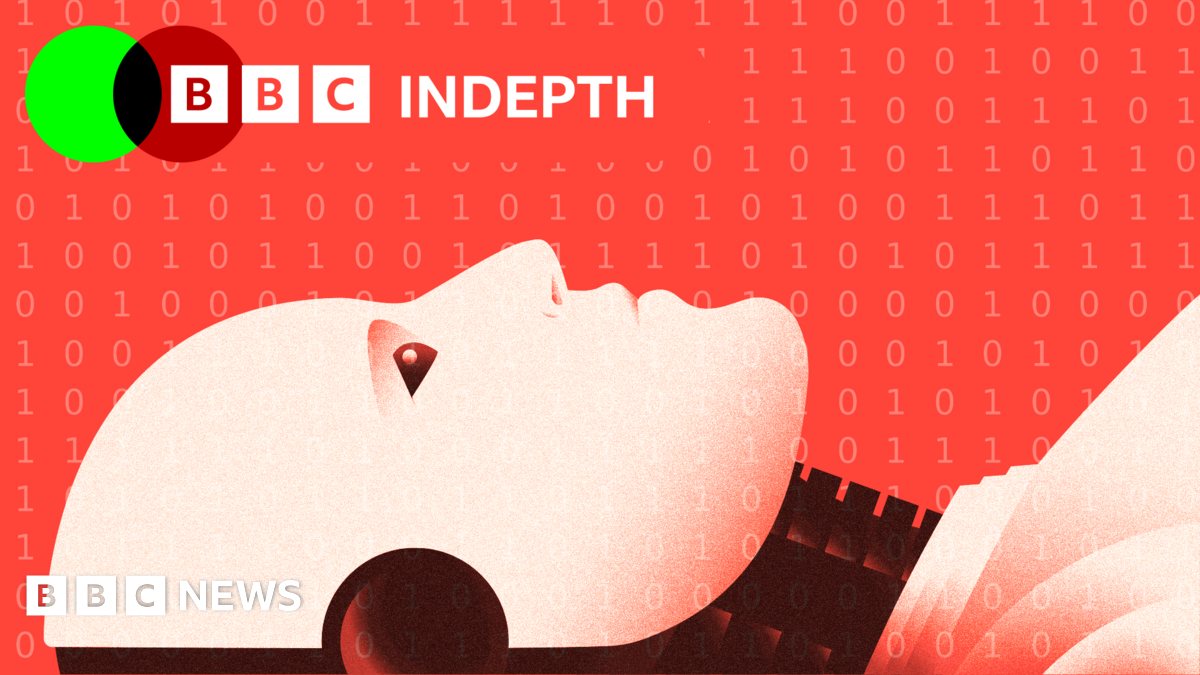Apple just proved AI "reasoning" models like Claude, DeepSeek-R1, and o3-mini don't actually reason at all. They just memorize patterns really well.
-
LOOK MAA I AM ON FRONT PAGE
hey I cant recognize patterns so theyre smarter than me at least
-
Other way around. The claimed meaningful change (reasoning) has not occurred.
Meaningful change is not happening because of this paper, either, I don't know why you're playing semantic games with me though.
-
I think it's an easy mistake to confuse sentience and intelligence. It happens in Hollywood all the time - "Skynet began learning at a geometric rate, on July 23 2004 it became self-aware" yadda yadda
But that's not how sentience works. We don't have to be as intelligent as Skynet supposedly was in order to be sentient. We don't start our lives as unthinking robots, and then one day - once we've finally got a handle on calculus or a deep enough understanding of the causes of the fall of the Roman empire - we suddenly blink into consciousness. On the contrary, even the stupidest humans are accepted as being sentient. Even a young child, not yet able to walk or do anything more than vomit on their parents' new sofa, is considered as a conscious individual.
So there is no reason to think that AI - whenever it should be achieved, if ever - will be conscious any more than the dumb computers that precede it.
Good point.
-
Meaningful change is not happening because of this paper, either, I don't know why you're playing semantic games with me though.
I don't know why you're playing semantic games
I'm trying to highlight the goal of this paper.
This is a knock them down paper by Apple justifying (to their shareholders) their non investment in LLMs. It is not a build them up paper trying for meaningful change and to create a better AI.
-
I don't know why you're playing semantic games
I'm trying to highlight the goal of this paper.
This is a knock them down paper by Apple justifying (to their shareholders) their non investment in LLMs. It is not a build them up paper trying for meaningful change and to create a better AI.
That's not the only way to make meaningful change, getting people to give up on llms would also be meaningful change. This does very little for anyone who isn't apple.
-
I hate this analogy. As a throwaway whimsical quip it'd be fine, but it's specious enough that I keep seeing it used earnestly by people who think that LLMs are in any way sentient or conscious, so it's lowered my tolerance for it as a topic even if you did intend it flippantly.
I don't mean it to extol LLM's but rather to denigrate humans. How many of us are self imprisoned in echo chambers so we can have our feelings validated to avoid the uncomfortable feeling of thinking critically and perhaps changing viewpoints?
Humans have the ability to actually think, unlike LLM's. But it's frightening how far we'll go to make sure we don't.
-
the fact that it is a fixed function, that only depends on the context AND there are a finite number of discrete inputs possible does make it equivalent to a huge, finite table. You really don't want this to be true. And again, you are describing training. Once training finishes anything you said does not apply anymore and you are left with fixed, unchanging matrices, which in turn means that it is a mathematical function of the context (by the mathematical definition of "function". stateless, and deterministic) which also has the property that the set of all possible inputs is finite. So the set of possible outputs is also finite and strictly smaller or equal to the size of the set of possible inputs. This makes the actual function that the tokens are passed through CAN be precomputed in full (in theory) making it equivalent to a conventional state transition table.
This is true whether you'd like it to or not. The training process builds a markov chain.
You’re absolutely right that inference in an LLM is a fixed, deterministic function after training, and that the input space is finite due to the discrete token vocabulary and finite context length. So yes, in theory, you could precompute every possible input-output mapping and store them in a giant table. That much is mathematically valid. But where your argument breaks down is in claiming that this makes an LLM equivalent to a conventional Markov chain in function or behavior.
A Markov chain is not simply defined as “a function from finite context to next-token distribution.” It is defined by a specific type of process where the next state depends on the current state via fixed transition probabilities between discrete states. The model operates over symbolic states with no internal computation. LLMs, even during inference, compute outputs via multi-layered continuous transformations, with attention mixing, learned positional embeddings, and non-linear activations. These mechanisms mean that while the function is fixed, its structure does not resemble a state machine—it resembles a hierarchical pattern recognizer and function approximator.
Your claim is essentially that “any deterministic function over a finite input space is equivalent to a table.” This is true in a computational sense but misleading in a representational and behavioral sense. If I gave you a function that maps 4096-bit inputs to 50257-dimensional probability vectors and said, “This is equivalent to a transition table,” you could technically agree, but the structure and generative capacity of that function is not Markovian. That function may simulate reasoning, abstraction, and composition. A Markov chain never does.
You are collapsing implementation equivalence (yes, the function could be stored in a table) with model equivalence (no, it does not behave like a Markov chain). The fact that you could freeze the output behavior into a lookup structure doesn’t change that the lookup structure is derived from a fundamentally different class of computation.
The training process doesn’t “build a Markov chain.” It builds a function that estimates conditional token probabilities via optimization over a non-Markov architecture. The inference process then applies that function. That makes it a stateless function, yes—but not a Markov chain. Determinism plus finiteness does not imply Markovian behavior.
-
I'd encourage you to research more about this space and learn more.
As it is, the statement "Markov chains are still the basis of inference" doesn't make sense, because markov chains are a separate thing. You might be thinking of Markov decision processes, which is used in training RL agents, but that's also unrelated because these models are not RL agents, they're supervised learning agents. And even if they were RL agents, the MDP describes the training environment, not the model itself, so it's not really used for inference.
I mean this just as an invitation to learn more, and not pushback for raising concerns. Many in the research community would be more than happy to welcome you into it. The world needs more people who are skeptical of AI doing research in this field.
Which method, then, is the inference built upon, if not the embeddings? And the question still stands, how does "AI" escape the inherent limits of statistical inference?
-
You’re absolutely right that inference in an LLM is a fixed, deterministic function after training, and that the input space is finite due to the discrete token vocabulary and finite context length. So yes, in theory, you could precompute every possible input-output mapping and store them in a giant table. That much is mathematically valid. But where your argument breaks down is in claiming that this makes an LLM equivalent to a conventional Markov chain in function or behavior.
A Markov chain is not simply defined as “a function from finite context to next-token distribution.” It is defined by a specific type of process where the next state depends on the current state via fixed transition probabilities between discrete states. The model operates over symbolic states with no internal computation. LLMs, even during inference, compute outputs via multi-layered continuous transformations, with attention mixing, learned positional embeddings, and non-linear activations. These mechanisms mean that while the function is fixed, its structure does not resemble a state machine—it resembles a hierarchical pattern recognizer and function approximator.
Your claim is essentially that “any deterministic function over a finite input space is equivalent to a table.” This is true in a computational sense but misleading in a representational and behavioral sense. If I gave you a function that maps 4096-bit inputs to 50257-dimensional probability vectors and said, “This is equivalent to a transition table,” you could technically agree, but the structure and generative capacity of that function is not Markovian. That function may simulate reasoning, abstraction, and composition. A Markov chain never does.
You are collapsing implementation equivalence (yes, the function could be stored in a table) with model equivalence (no, it does not behave like a Markov chain). The fact that you could freeze the output behavior into a lookup structure doesn’t change that the lookup structure is derived from a fundamentally different class of computation.
The training process doesn’t “build a Markov chain.” It builds a function that estimates conditional token probabilities via optimization over a non-Markov architecture. The inference process then applies that function. That makes it a stateless function, yes—but not a Markov chain. Determinism plus finiteness does not imply Markovian behavior.
you wouldn't be "freezing" anything. Each possible combination of input tokens maps to one output probability distribution. Those values are fixed and they are what they are whether you compute them or not, or when, or how many times.
Now you can either precompute the whole table (theory), or somehow compute each cell value every time you need it (practice). In either case, the resulting function (table lookup vs matrix multiplications) takes in only the context, and produces a probability distribution. And the mapping they generate is the same for all possible inputs. So they are the same function. A function can be implemented in multiple ways, but the implementation is not the function itself. The only difference between the two in this case is the implementation, or more specifically, whether you precompute a table or not. But the function itself is the same.
You are somehow saying that your choice of implementation for that function will somehow change the function. Which means that according to you, if you do precompute (or possibly cache, full precomputation is just an infinite cache size) individual mappings it somehow magically makes some magic happen that gains some deep insight. It does not. We have already established that it is the same function.
-
LOOK MAA I AM ON FRONT PAGE
WTF does the author think reasoning is
-
That depends on your assumption that the left would have anything relevant to gain by embracing AI (whatever that's actually supposed to mean).
Saw this earlier in the week and thought of you. These short, funny videos are popping up more and more and they're only getting better. They’re sharp, engaging, and they spread like wildfire.
You strike me as someone who gets it what it means when one side embraces the latest tools while the other rejects them.
The left is still holed up on Lemmy, clinging to “Fuck AI” groups. But why? Go back to the beginning. Look at the early coverage of AI it was overwhelmingly targeted at left-leaning spaces, full of panic and doom. Compare that to how the right talks about immigration. The headlines are cut and pasted from each other. Same playbook, different topic. The media set out to alienate the left from these tools.

71 reactions · 11 shares | I’m just tryna KICK it bro 🤷🏾♂️👟 Share for the Marines in Los Angeles ICE riots ! Follow @themarinerapper for more ai military and music videos. | The Marine Rapper
I’m just tryna KICK it bro 🤷🏾♂️👟 Share for the Marines in Los Angeles ICE riots ! Follow @themarinerapper for more ai military and music videos..
(www.facebook.com)
-
Saw this earlier in the week and thought of you. These short, funny videos are popping up more and more and they're only getting better. They’re sharp, engaging, and they spread like wildfire.
You strike me as someone who gets it what it means when one side embraces the latest tools while the other rejects them.
The left is still holed up on Lemmy, clinging to “Fuck AI” groups. But why? Go back to the beginning. Look at the early coverage of AI it was overwhelmingly targeted at left-leaning spaces, full of panic and doom. Compare that to how the right talks about immigration. The headlines are cut and pasted from each other. Same playbook, different topic. The media set out to alienate the left from these tools.

71 reactions · 11 shares | I’m just tryna KICK it bro 🤷🏾♂️👟 Share for the Marines in Los Angeles ICE riots ! Follow @themarinerapper for more ai military and music videos. | The Marine Rapper
I’m just tryna KICK it bro 🤷🏾♂️👟 Share for the Marines in Los Angeles ICE riots ! Follow @themarinerapper for more ai military and music videos..
(www.facebook.com)
I don't have even the slightest idea what that video is supposed to mean. (Happy cake day tho.)
-
I don't have even the slightest idea what that video is supposed to mean. (Happy cake day tho.)
Come on, you know what I’m talking about. It’s a channel that started with AI content and is now pivoting to videos about the riots. You can see where this is going. Sooner or later, it’ll expand into targeting protestors and other left-leaning causes.
It’s a novelty now, but it’s spreading fast, and more channels like it are popping up every day.
Meanwhile, the left is losing ground. Losing cultural capture. Because as a group, they’re being manipulated into isolating themselves from the very tools and platforms that shape public opinion. Social media. AI. All of it. They're walking away from the battlefield while the other side builds momentum.
-
Come on, you know what I’m talking about. It’s a channel that started with AI content and is now pivoting to videos about the riots. You can see where this is going. Sooner or later, it’ll expand into targeting protestors and other left-leaning causes.
It’s a novelty now, but it’s spreading fast, and more channels like it are popping up every day.
Meanwhile, the left is losing ground. Losing cultural capture. Because as a group, they’re being manipulated into isolating themselves from the very tools and platforms that shape public opinion. Social media. AI. All of it. They're walking away from the battlefield while the other side builds momentum.
you know what I’m talking about
But I literally don't. Well, I didn't but now I mostly do, since you explained it.
I get what you're saying with regards to the isolation, this issue has already been raised when many left-wing people started to leave Twitter. But it is opening a whole new can of worms - these profiles that post AI-generated content are largely not managed by ordinary people with their private agendas (sharing neat stuff, political agitation, etc.), but by bots, and are also massively followed and supported by other bot profiles. Much the same on Twitter with its hordes of right-wing troll profiles, and as I'm still somewhat active on reddit I also notice blatant manipluation there as well (my country had elections a few weeks ago and the flood of new profiles less than one week old spamming idiotic propaganda and insults was too obvious). It's not organic online behaviour and it can't really be fought by organic behaviour, especially when the big social media platforms give up the tools to fight it (relaxing their moderation standards, removing fact-checking, etc.). Lemmy and Mastodon etc. are based on the idea(l) that this corporate-controlled area is not the only space where meaningful activity can happen.
So that's one side of the story, AI is not something happening in a vacuum and that you just have to submit to your own will. The other side of the story, the actual abilities of AI, have already been discussed, we've seen sufficiently that it's not that good at helping people form more solidly developed and truth-based stances. Maybe it could be used to spread the sort of mass-produced manipulative bullshit that is already used by the right, but I can't honestly support such stuff. In this regard, we can doubt whether there is any ground to win for the left (would the left's possible audience actually eat it up), and if yes, whether it is worth it (basing your political appeal on bullshit can bite you in the ass down the line).
As for the comparison to discourse around immigrants, again I still don't fully understand the point other than on the most surface level (the media is guiding people what to think, duh).






